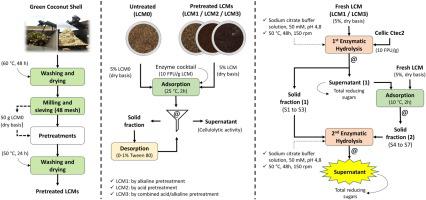Industrial Crops and Products ( IF 5.9 ) Pub Date : 2021-09-11 , DOI: 10.1016/j.indcrop.2021.114037 Petrúcia Karine Santos de Brito Bezerra 1 , Otávio Lima da Silva 1 , Sérgio Dantas de Oliveira Júnior 1 , Carlos Eduardo de Araújo Padilha 1 , Everaldo Silvino dos Santos 1

|
Lignocellulosic bioconversion to obtain fermentable sugars often requires high enzyme dosages, increasing the total production cost. This study investigated the adsorption, desorption, and recycling of cellulases in enzymatic hydrolysis experiments using pretreated green coconut shell as substrate. The green coconut shell (GCS) was subjected to different pretreatments including dilute acid, alkaline, and two-stage acid-alkaline pretreatments. Adsorption and desorption studies involving cellulases from Trichoderma reesei ATCC 26921 and Cellic Ctec2 (10 FPU/g, initial dosage) with 5% solid loading showed that alkaline and two-stage acid-alkaline pretreatments were more suitable for enzyme recycling, because they showed lower values of cellulase adsorption capacity (48 % and 69 %) and higher values of cellulase recovery by desorption without Tween 80 addition (reaching 50 % using two-stage acid-alkaline pretreated GCS). Cellulases bound to the solid residue and dissolved in the supernatant after enzymatic hydrolysis can be reused for a new enzymatic hydrolysis process without compromising the sugar yield results. Using GCS as a substrate, the addition of solid residue and the supernatant from the previous step of adsorption of cellulases achieved a satisfactory sugar yield g/g (73.0 % for LCM1 and 60.0 % for LCM3) using less enzyme (just using recycled enzyme with no new enzyme added to the system) than the control case. Thus, it was possible to recycle the cellulases in two successive hydrolysis cycles with reduced enzyme load to achieve the same reducing sugar yields (up to 84 %), enabling cheaper and more efficient hydrolysis of lignocellulosic biomass.
中文翻译:

脱木素绿椰子残渣中纤维素分解酶的行为和酶促水解与酶回收
获得可发酵糖的木质纤维素生物转化通常需要高剂量的酶,从而增加了总生产成本。本研究使用预处理的绿色椰子壳作为底物,研究了纤维素酶在酶促水解实验中的吸附、解吸和回收。对绿色椰子壳 (GCS) 进行不同的预处理,包括稀酸、碱和两阶段酸碱预处理。涉及里氏木霉纤维素酶的吸附和解吸研究ATCC 26921 和 Cellic Ctec2(10 FPU/g,初始剂量)和 5% 固含量表明碱性和两阶段酸碱预处理更适合酶回收,因为它们显示出较低的纤维素酶吸附能力值(48% 和69 %) 和更高值的解吸纤维素酶回收率,不添加吐温 80(使用两阶段酸碱预处理 GCS 达到 50%)。纤维素酶与固体残留物结合并在酶促水解后溶解在上清液中,可重新用于新的酶促水解过程,而不会影响糖产量结果。使用 GCS 作为底物,添加固体残留物和来自纤维素酶吸附前一步的上清液,实现了令人满意的糖产量 g/g(LCM1 和 60.0 为 73.0%。LCM3 为 0 %) 使用的酶比对照情况少(仅使用回收酶,没有向系统添加新酶)。因此,可以在酶负荷降低的两个连续水解循环中回收纤维素酶,以实现相同的还原糖产率(高达 84%),从而能够更便宜、更有效地水解木质纤维素生物质。



























 京公网安备 11010802027423号
京公网安备 11010802027423号